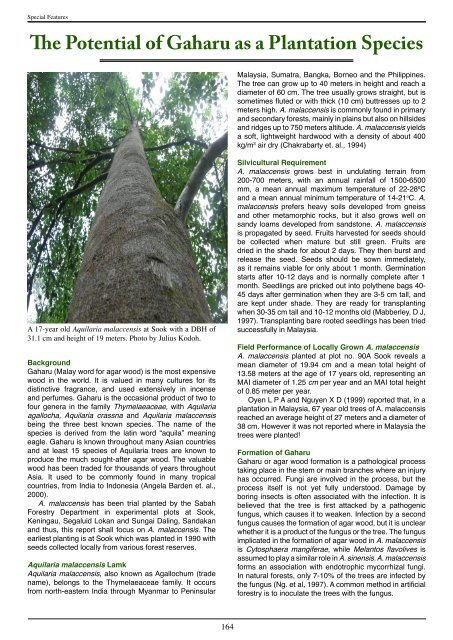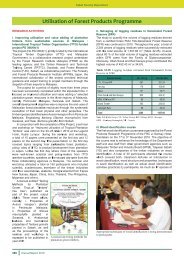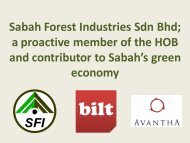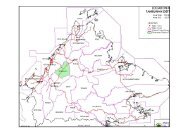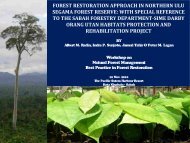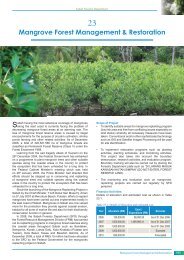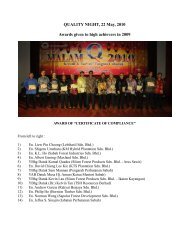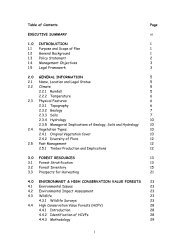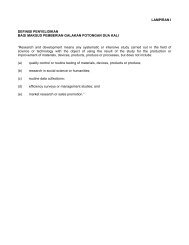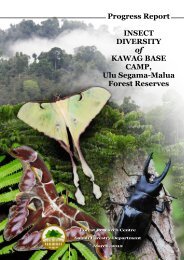22i Gaharu.pdf - Sabah Forestry Department
22i Gaharu.pdf - Sabah Forestry Department
22i Gaharu.pdf - Sabah Forestry Department
- No tags were found...
You also want an ePaper? Increase the reach of your titles
YUMPU automatically turns print PDFs into web optimized ePapers that Google loves.
Special FeaturesThe Potential of <strong>Gaharu</strong> as a Plantation SpeciesMalaysia, Sumatra, Bangka, Borneo and the Philippines.The tree can grow up to 40 meters in height and reach adiameter of 60 cm. The tree usually grows straight, but issometimes fluted or with thick (10 cm) buttresses up to 2meters high. A. malaccensis is commonly found in primaryand secondary forests, mainly in plains but also on hillsidesand ridges up to 750 meters altitude. A. malaccensis yieldsa soft, lightweight hardwood with a density of about 400kg/m 3 air dry (Chakrabarty et. al., 1994)A 17-year old Aquilaria malaccensis at Sook with a DBH of31.1 cm and height of 19 meters. Photo by Julius Kodoh.Background<strong>Gaharu</strong> (Malay word for agar wood) is the most expensivewood in the world. It is valued in many cultures for itsdistinctive fragrance, and used extensively in incenseand perfumes. <strong>Gaharu</strong> is the occasional product of two tofour genera in the family Thymelaeaceae, with Aquilariaagallocha, Aquilaria crassna and Aquilaria malaccensisbeing the three best known species. The name of thespecies is derived from the latin word “aquila” meaningeagle. <strong>Gaharu</strong> is known throughout many Asian countriesand at least 15 species of Aquilaria trees are known toproduce the much sought-after agar wood. The valuablewood has been traded for thousands of years throughoutAsia. It used to be commonly found in many tropicalcountries, from India to Indonesia (Angela Barden et. al.,2000).A. malaccensis has been trial planted by the <strong>Sabah</strong><strong>Forestry</strong> <strong>Department</strong> in experimental plots at Sook,Keningau, Segaluid Lokan and Sungai Daling, Sandakanand thus, this report shall focus on A. malaccensis. Theearliest planting is at Sook which was planted in 1990 withseeds collected locally from various forest reserves.Aquilaria malaccensis LamkAquilaria malaccensis, also known as Agallochum (tradename), belongs to the Thymelaeaceae family. It occursfrom north-eastern India through Myanmar to PeninsularSilvicultural RequirementA. malaccensis grows best in undulating terrain from200-700 meters, with an annual rainfall of 1500-6500mm, a mean annual maximum temperature of 22-28 0 Cand a mean annual minimum temperature of 14-21 o C. A.malaccensis prefers heavy soils developed from gneissand other metamorphic rocks, but it also grows well onsandy loams developed from sandstone. A. malaccensisis propagated by seed. Fruits harvested for seeds shouldbe collected when mature but still green. Fruits aredried in the shade for about 2 days. They then burst andrelease the seed. Seeds should be sown immediately,as it remains viable for only about 1 month. Germinationstarts after 10-12 days and is normally complete after 1month. Seedlings are pricked out into polythene bags 40-45 days after germination when they are 3-5 cm tall, andare kept under shade. They are ready for transplantingwhen 30-35 cm tall and 10-12 months old (Mabberley, D J,1997). Transplanting bare rooted seedlings has been triedsuccessfully in Malaysia.Field Performance of Locally Grown A. malaccensisA. malaccensis planted at plot no. 90A Sook reveals amean diameter of 19.94 cm and a mean total height of13.58 meters at the age of 17 years old, representing anMAI diameter of 1.25 cm per year and an MAI total heightof 0.85 meter per year.Oyen L P A and Nguyen X D (1999) reported that, in aplantation in Malaysia, 67 year old trees of A. malaccensisreached an average height of 27 meters and a diameter of38 cm. However it was not reported where in Malaysia thetrees were planted!Formation of <strong>Gaharu</strong><strong>Gaharu</strong> or agar wood formation is a pathological processtaking place in the stem or main branches where an injuryhas occurred. Fungi are involved in the process, but theprocess itself is not yet fully understood. Damage byboring insects is often associated with the infection. It isbelieved that the tree is first attacked by a pathogenicfungus, which causes it to weaken. Infection by a secondfungus causes the formation of agar wood, but it is unclearwhether it is a product of the fungus or the tree. The fungusimplicated in the formation of agar wood in A. malaccensisis Cytosphaera mangiferae, while Melantos flavolives isassumed to play a similar role in A. sinensis. A. malaccensisforms an association with endotrophic mycorrhizal fungi.In natural forests, only 7-10% of the trees are infected bythe fungus (Ng. et al, 1997). A common method in artificialforestry is to inoculate the trees with the fungus.164
The Potential of <strong>Gaharu</strong> as a Plantation SpeciesUsesAgar wood is the rare and famous, resin containingheartwood produced from old and diseased trees of severalAquilaria species of which A. malaccensis, A. crassna andA. sinensis are most important. The fragrance producedby the burning agar wood has been highly valued forthousands of years, and its use as incense for ceremonialpurposes in Buddhism, Confucianism and Hinduism iswidespread throughout eastern and southern Asia. Thewood is only partly saturated with resin but still fragrant,and occasionally, the wood remaining after distillation, ismade into sticks called ‘joss sticks’ or ‘agarbattis’ whichare burnt as incense. Agar wood oil is an essential oilobtained by water and steam distillation of agar wood,which is used in luxury perfumery. The incense is alsoused as an insect repellent and for medicines. The timberof undiseased trees, known as ‘karas’, is very light and isonly suitable for making boxes, light indoor constructionand veneer [Angela Barden et al (2000)].MarketAgar wood has become a precious commodity. Accordingto Angela Burden et al (2000), based on available tradedata, Indonesia and Malaysia appear to be the mainsources of agarwood (from all species) in internationaltrade. CITES reported that exports of A. malaccensis fromIndonesia topped 920 t from 1995 to 1997, although CITESargue that it might include other species of Aquilaria. Over340 t of A. malaccensis were reported as exported fromPeninsular Malaysia during the same period. AngelaBurden et al (2000) also reported that according toSarawak’s CITES Management Authority, nearly 530 tof A malaccensis were exported from Sarawak alone in1998. Although overall trade volume may appear small in“timber trade” terms, but they are not small in monetaryterms. Most of agarwood in international trade is destinedfor consumers in the Far and Middle East, with key finalexport destinations from 1995 to 1997 being Saudi Arabia,the United Arab Emirates, Hong Kong and Taiwan.Chakrabarty et al (1994) stated that the lowest gradeof Malaysian agarwood (not necessarily A. malaccensis)could be obtained for USD19/kg in the Middle East. Thehigh grades, normally reserved for exclusive buyers, cancost up to USD9589/kg. More expensive grades are alsoavailable and can sell for as much as USD27400/kg.The A. malaccensis tree is comparative to gold and isbecoming very rare in the wild due to illegal extraction.Thus, the species has been CITES listed in Appendix II.The listing subjects the species to limited commercial useand stringent monitoring through a permit system. UnderCITES rules, the Management Authority will issue CITESExport Permit to exporters of gaharu which originate fromMalaysia, CITES Import Permit to importers of gaharu,and CITES Re-Export Certificate to traders of this specieswhich originate from other countries. The Importers arerequested to furnish the CITES Export Permit from theexporting country before the Management Authority canissue the CITES Import Permit.ProspectsThe extremely high prices paid for high quality agar woodand for the essential oil and the indiscriminate felling ofdiseased and healthy trees threaten natural stands ofAquilaria including A. malaccensis to extinction. Researchinto possibilities of artificial induction and stimulation ofagar wood formation is therefore urgently required andNine year old Aquilaria malaccensis planted at Sook, Keningau.(Photo by Julius Kodoh)may offer high economic returns, especially as trialsindicate that management of plantations presents nogreat difficulties. Unless such methods are developed, A.malaccensis may soon be extinct.Today, gaharu is becoming more popular in Malaysia.Projects are currently underway in some countries inSoutheast Asia to infect cultivated Aquilaria trees artificiallyto produce gaharu in a sustainable manner. In Malaysia,various Research Institutions are conducting research anddevelopment on Aquilatria trees. The Forest ResearchCentre of the <strong>Sabah</strong> <strong>Forestry</strong> <strong>Department</strong> has recentlyundertaken a collaborative project to artificially inoculategaharu trees to induce the formation of agarwood in oneof the planted <strong>Gaharu</strong> plots. What remains to be seen isthe success of this project, but if it proves to be successful,it will be a breakthrough in terms of its socio-economicpotential as well as in protecting the remaining gaharutrees available in the wild.ReferencesAngela Barden, Noorainie Awang Anak, Teresa Mullikenand Michael Song (2000), Heart Of The Matter: AgarwoodUse And Trade And Cites Implementation For AquilariaMalaccensis.@http://www.traffic.org/news/agarwood.<strong>pdf</strong>.Chakrabarty K, Kumar A and Menon V (1994), Trade inAgarwood. Traffic India and WWF-India, New Delhi.51pp.Mabberley D J (1997), The Plant Book, The PressSyndicate of the University of Cambridge, UK, 858pp.Ng L.T., Chang Y.S. and Kadir A.A. (1997), A Review onAgar (gaharu) producing Aquilaria species, Journal ofTropical Forest Products 2(2): 272-285.Oyen L.P.A and Nguyen Xuan Dung (Editors), 1999. PlantResources of South-East Asia No 19. Essential-Oil Plants.Backhuys Publishers, Leiden, the Netherland.165


